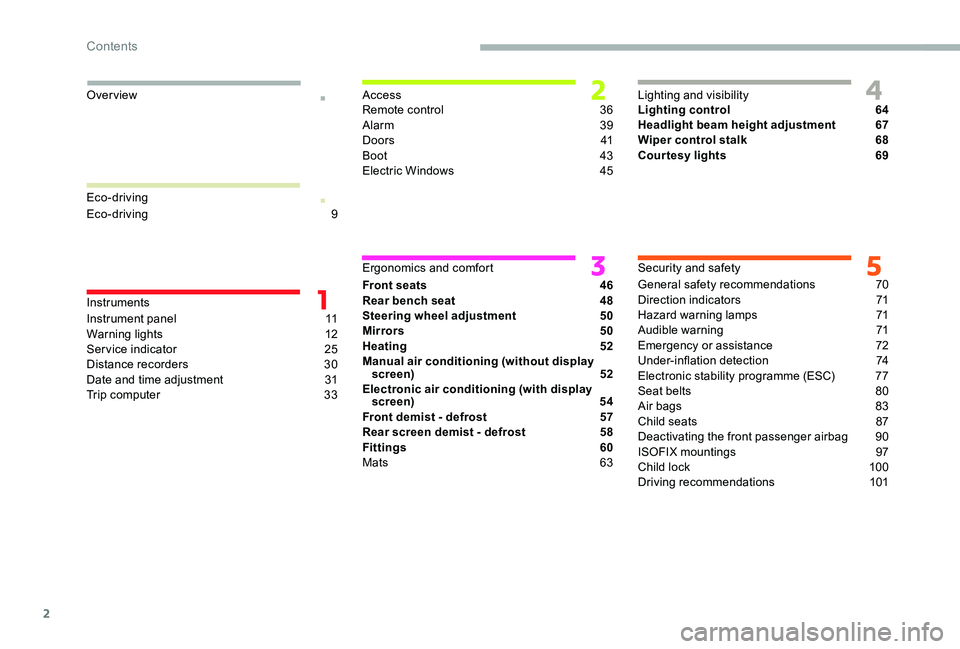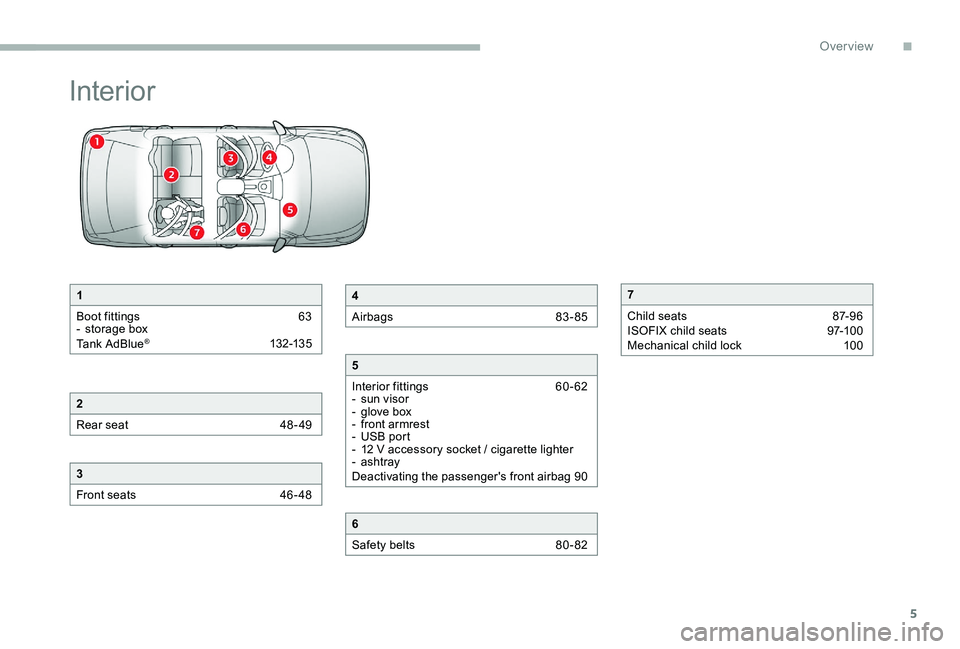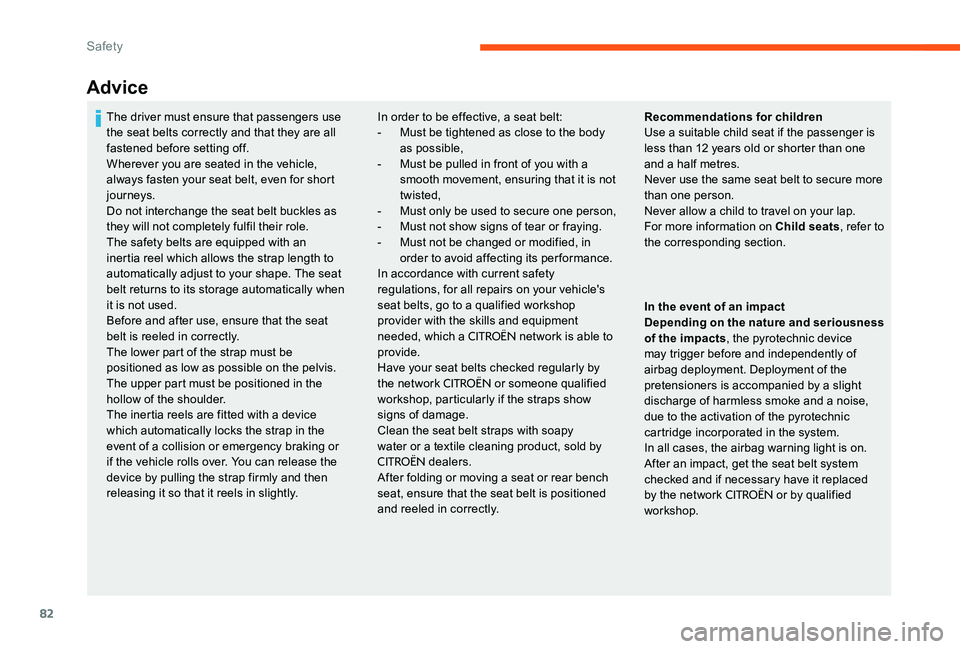seats CITROEN C-ELYSÉE 2017 Handbook (in English)
[x] Cancel search | Manufacturer: CITROEN, Model Year: 2017, Model line: C-ELYSÉE, Model: CITROEN C-ELYSÉE 2017Pages: 306, PDF Size: 9.34 MB
Page 4 of 306

2
.
.
Instrument panel 11
Warning lights 1 2
Service indicator
2
5
Distance recorders
3
0
Date and time adjustment
3
1
Trip computer
3
3Remote control
3
6
Alarm
39
D o o r s
41
Boo
t
43
Electric Windows
4
5
Front seats
4
6
Rear bench seat
4
8
Steering wheel adjustment 5 0
Mirrors 50
Heating
52
Manual air conditioning (without display screen)
52
Electronic air conditioning (with display screen)
5
4
Front demist - defrost
5
7
Rear screen demist - defrost
5
8
Fittings
60
Mats
6
3Lighting control
6
4
Headlight beam height adjustment
6
7
Wiper control stalk
6
8
Courtesy lights
6
9
General safety recommendations
7
0
Direction indicators
7
1
Hazard warning lamps 7 1
Audible warning 7 1
Emergency or assistance
7
2
Under-inflation detection
7
4
Electronic stability programme (ESC)
7
7
Seat belts
8
0
Air bags
8
3
Child seats
87
D
eactivating the front passenger airbag
9
0
ISOFIX mountings
9
7
Child lock
1
00
Driving recommendations
1
01
Eco-driving
9
Eco-driving
Instruments Access
Over view
Ergonomics and comfortLighting and visibility
Security and safety
Contents
Page 7 of 306

5
Interior
1
Boot fittings
6
3
-
s
torage box
Tank AdBlue
® 132-13 5
2
Rear seat
4
8- 49
3
Front seats
4
6 - 48
4
Airbags
8
3-85
5
Interior fittings
6
0-62
-
s
un visor
-
g
love box
-
f
ront armrest
-
U
SB port
-
1
2 V accessory socket / cigarette lighter
-
ashtray
Deactivating the passenger's front airbag
9
0
6
Safety belts
8
0-82
7
Child seats
87
-96
ISOFIX child seats
9
7-100
Mechanical child lock
1
00
.
Over view
Page 12 of 306

10
Limit the causes of
excess consumption
Spread loads throughout the vehicle; place
the heaviest items in the bottom of the boot,
as close as possible to the rear seats.
Limit the loads carried in the vehicle and
reduce wind resistance (roof bars, roof rack,
bicycle carrier, trailer...). Preferably use a roof
box.
Remove roof bars and roof racks after use.
At the end of winter, remove snow tyres and
refit your summer tyres.
Observe the recommendations
on maintenance
Check the tyre pressures regularly, when cold,
referring to the label in the door aperture,
driver's side.
Carry out this check in particular:
-
b
efore a long journey,
-
a
t each change of season,
-
a
fter a long period out of use.
Don't forget the spare wheel and the tyres on
any trailer or caravan. Have your vehicle serviced regularly (engine
oil, oil filter, air filter, etc.) and observe the
schedule of operations recommended by the
manufacturer.
When filling the tank, do not continue after the
3
rd cut-off of the nozzle to avoid over flow.
At the wheel of your new vehicle, it is only
after the first 1,800 miles (3,000 kilometres)
that you will see the fuel consumption settle
down to a consistent average.
Eco-driving
Page 46 of 306

44
Back-up release
System for mechanically unlocking the boot in
the event of a battery or central locking fault.
Unlocking
F Fold back the rear seats to gain access to the lock from inside the boot.
F
I
nsert a small screwdriver into hole A of the
lock to unlock the tailgate.
If your vehicle is fitted with a fixed bench
seat, contact a
CITROËN dealer or a
qualified workshop.
Locking / unlocking from inside
F Press this button to lock or unlock the doors and boot.
If one of the doors is open, the centralised
locking did not work.
Locking from outside
When the vehicle is locked from outside,
the button does not work.
F
T
o unlock the vehicle, pull the interior
door lever.
Automatic central locking
of the doors
The doors can lock automatically while driving
(speed above 6 mph [10 km/h]).
Driving with the doors locked may render
access by the emergency services to the
interior difficult in an emergency. F
T
o activate or deactivate this
function (activated by default),
press this button until a buzzer
sounds and/or a message
appears in the screen.
Access
Page 48 of 306

46
Front seats
As a safety measure, adjustments to the driver's seat must only be done when stationary.
Forwards-backwards
F Raise the control and slide the seat forwards or backwards.
Before moving the seat backwards, ensure that there is nothing that might prevent the full
travel of the seat.
There is a risk of trapping or pinching passengers if present in the rear seats or jamming the
seat if large objects are placed on the floor behind the seat.
Tilting the backrest
F Press the control backwards.
Height (driver only)
F Pull the control upwards to raise or push it downwards to lower, as many times as
necessary, to obtain the position required.
Ease of use and comfort
Page 50 of 306

48
Prolonged use at the is not recommended
for those with sensitive skin.
There is a risk of burns for people whose
perception of heat is impaired (illness,
taking medication, etc.).
There is a risk of overheating the system if
material with insulating properties is used,
such as cushions or seat covers.
Do not use the system:
-
i
f wearing damp clothing,
-
i
f child seats are fitted.
To avoid breaking the heating element in
the seat:
-
d
o not place heavy objects on the
seat,
-
d
o not kneel or stand on the seat,
-
d
o not place sharp objects on the
seat,
-
d
o not spill liquids onto the seat.
To avoid the risk of short-circuit:
-
d
o not use liquid products for cleaning
the seat,
-
n
ever use the heating function when
the seat is damp.
Rear bench seat
Depending on the version, your vehicle is equipped with one of these three bench seats:
- F ixed bench seat.
For removing and refitting it, contact a
CITROËN dealer or a qualified workshop.
-
B
ench seat with fixed one-piece cushion and split folding backrest (left hand 2/3,
right hand 1/3):
-
w
ith fixed head restraints.
-
w
ith adjustable head restraints.
Folding the backrest
F If necessary, move the corresponding front seat forward.
F
C
heck that the corresponding seat belt is
positioned correctly against the backrest
and buckle it. F
P
ull the strap 1 to release the seat
backrest 2 .
F
F
old the seat back 2 on to the cushion.
Ease of use and comfort
Page 69 of 306

67
Headlight beam height adjustment
To avoid causing a nuisance to other road
users, the height of the headlight beams should
be adjusted according to the load in the vehicle.
Depending on the version, this adjustment can
be carried out using the control located:
-
U
nder the bonnet.
-
T
o the left of the steering wheel
Bonnet
F Raise the bonnet to access the control (one per headlight).
F
T
urn the control to adjust the height of the
headlight beam.
To the left of the steering wheel
0 1 or 2 people in the front seats.
- 5 people.
1 5 people + maximum authorised load in
the boot.
- Driver on his own + maximum authorised
load in the boot.
The higher number positions can be used, but
may limit the area illuminated by the headlights.
The initial setting is position "0". Travelling abroad
The design of the dipped beam headlights
allows, without modification, driving in a
country that drives on the other side of the
road to the country in which your vehicle
was sold.
4
Lighting and visibility
Page 82 of 306

80
Seat belts
Front seat belts
LockingSeat belt not fastened /
unfastening warning light
When the ignition is switched on,
this warning light comes on in the
instrument panel, if the driver has
not fastened his/her seat belt.
From approximately 12 mph (20 km/h),
this warning light flashes for two minutes
accompanied by an audible signal of increasing
volume. Once these two minutes have elapsed,
this warning light remains on until the driver
fastens their seat belt.
This warning lamp also illuminates in the
instrument panel if the driver and/or front
passenger unfastens his/her seat belt while
driving.*
The front seat belts are fitted with a pyrotechnic
pretensioning and force limiting system.
This system improves safety in the front
seats in the event of a front or side impact.
Depending on the severity of the impact, the
pretensioning system instantly tightens the seat
belts against the body of the occupants.
The pretensioning seat belts are active when
the ignition is on.
The force limiter reduces the pressure of the
seat belt on the chest of the occupant, thus
improving their protection. F
P
ull the strap then insert the tongue in the
buckle.
F
C
heck that the seat belt is fastened
correctly by pulling the strap.
Unlocking
F Press the red button on the buckle.
F G uide the seat belt as it reels in.
* Depending on the country of sale.
Safety
Page 83 of 306

81
Rear seat belts
Locking
F Pull the strap then insert the tongue in the buckle.
F
C
heck that the seat belt is fastened
correctly by pulling the strap.
Unlocking
F Press the red button on the buckle.
F G uide the seat belt as it reels in.
The right and left rear seats are each fitted with
a three-point inertia reel seat belt.
Depending on version, the centre rear seat is
fitted with a seat belt with or without reel, and
has three or two-point anchorages.
5
Safety
Page 84 of 306

82
Advice
In order to be effective, a seat belt:
- M ust be tightened as close to the body
as possible,
-
M
ust be pulled in front of you with a
smooth movement, ensuring that it is not
twisted,
-
M
ust only be used to secure one person,
-
M
ust not show signs of tear or fraying.
-
M
ust not be changed or modified, in
order to avoid affecting its per formance.
In accordance with current safety
regulations, for all repairs on your vehicle's
seat belts, go to a qualified workshop
provider with the skills and equipment
needed, which a
CITROËN network is able to
provide.
Have your seat belts checked regularly by
the network
CITROËN or someone qualified
workshop, particularly if the straps show
signs of damage.
Clean the seat belt straps with soapy
water or a textile cleaning product, sold by
CITROËN dealers.
After folding or moving a seat or rear bench
seat, ensure that the seat belt is positioned
and reeled in correctly. Recommendations for children
Use a suitable child seat if the passenger is
less than 12 years old or shorter than one
and a half metres.
Never use the same seat belt to secure more
than one person.
Never allow a child to travel on your lap.
For more information on Child seats
, refer to
the corresponding section.
In the event of an impact
Depending on the nature and seriousness
of the impacts , the pyrotechnic device
may trigger before and independently of
airbag deployment. Deployment of the
pretensioners is accompanied by a slight
discharge of harmless smoke and a noise,
due to the activation of the pyrotechnic
cartridge incorporated in the system.
In all cases, the airbag warning light is on.
After an impact, get the seat belt system
checked and if necessary have it replaced
by the network
CITROËN or by qualified
workshop.
The driver must ensure that passengers use
the seat belts correctly and that they are all
fastened before setting off.
Wherever you are seated in the vehicle,
always fasten your seat belt, even for short
journeys.
Do not interchange the seat belt buckles as
they will not completely fulfil their role.
The safety belts are equipped with an
inertia reel which allows the strap length to
automatically adjust to your shape. The seat
belt returns to its storage automatically when
it is not used.
Before and after use, ensure that the seat
belt is reeled in correctly.
The lower part of the strap must be
positioned as low as possible on the pelvis.
The upper part must be positioned in the
hollow of the shoulder.
The inertia reels are fitted with a device
which automatically locks the strap in the
event of a collision or emergency braking or
if the vehicle rolls over. You can release the
device by pulling the strap firmly and then
releasing it so that it reels in slightly.
Safety